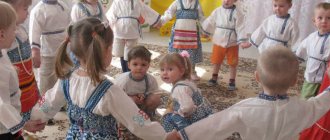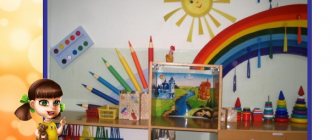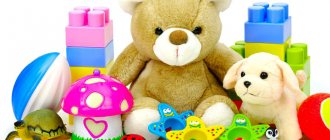Card index of word games senior group
CARD No. 1 Name the Goal quickly. Teach children, at a signal (passing the ball), to name the next number to increase (decrease). Rules of the game. At the beginning of the game, agree on the condition: call the numbers one more. The teacher throws the ball to one of the children and calls the number. The child catches the ball and, throwing it back, calls the number one unit more. The game is played at a fast pace. The players follow the answers and help the presenter. Complication. Say the numbers out of order. Children who count within large limits can name numbers greater than 5.
CARD No. 2
What do you mean where? Target. Teach children to navigate in space (from themselves). Rules of the game. Children form a circle. Using a counting rhyme, a leader is selected. One, two, three, four, five, we begin to play. We all need to be counted, One, two, three, four, five. The leader stands in the center of the circle and, throwing the ball to one of the children, asks: “What is to your right?” If the child gave the correct answer, he becomes the leader. Game continues. Questions could be: Who is on your left? Who's in front of you? What's overhead? Etc.
CARD No. 3 Don’t make a mistake Goal: to strengthen the children’s ability to call the next number to increase (decrease) at a signal (passing the ball). Rules of the game. Children form a circle. In the center of the circle is the teacher. He throws the ball to the child and calls the number. The child who catches the ball calls the next number and throws the ball to the teacher. Complication. Children form a circle, the teacher is with them. Tossing the ball to each other, they name the numbers in order. For example, a child says “one” and throws the ball to one of the children. The other person who catches the ball says “two” and throws the ball to whomever he wants.
CARD No. 4
Show as much Goal. Strengthen children's ability to correlate quantities with numbers. Rules of the game. The teacher invites the children to put the numbers in order, and put a card with circles under them. While the children are completing the task, the teacher puts out a certain number of toys. The children, having counted them, show the corresponding number and explain why they showed this particular number. The game is repeated with a change of toys. Game options: The child displays the toys; Instead of numbers, children show a card with circles; The teacher suggests showing a number that is one more or less
CARD No. 5 Who can name the most? Target. Strengthen children's knowledge about geometric shapes. Find them in your immediate environment. Rules of the game. Children are divided into two teams. The presenter asks them to name objects that have the shape of a quadrangle (square). For each correct answer, the team receives a chip. You cannot name the same object twice. The game is played at a fast pace.
CARD No. 6 Who knows, let the Goal count further. Teach children, at a signal (passing the ball), to name the next number to increase (decrease). Rules of the game. The game is played in a circle with a ball. An adult throws the ball to one of the children and calls any number. The child who caught the ball continues to count further (two more numbers) and returns the ball. The presenter again throws the ball to one of the children and calls the number. Complication. Those children who count within large numbers are called any of them.
CARD No. 7 Who will remember more? Target. Develop children's attention to memorizing geometric shapes. Rules of the game. Different geometric shapes (6 pieces) are placed in random order on the flannelgraph. Children look at them and remember them. The teacher counts to 3 and closes the figures. Offers to name as many figures as possible that were on the flannelgraph. Complication. Name not only the shapes, but also their colors.
CARD No. 8 Help the bunny Goal. Strengthen the ability to correlate an object with a number. Game material. Groups of vegetables, cards with numbers. Rules of the game. There are groups of vegetables on the flannelgraph. Educator. A little bunny came running to us, he wants to play. Close your eyes, and at this time he will put numbers next to the vegetables. Open your eyes, look and tell him if he put the numbers next to the vegetables correctly. Children close their eyes, the teacher puts numbers next to the groups of vegetables corresponding to the number of vegetables. Having opened their eyes, the children, after counting the groups, not only select the numbers, but also explain why they did so. Complication line. There are numbers on the flannelgraph. Children select groups of vegetables for them, and the bunny checks them.
CARD No. 9 Count and answer Purpose. Strengthen the ability to find homogeneous objects in the surrounding space and correlate their quantity with a number. Rules of the game. The game is played standing in a circle. Children have seven chips. Players take turns asking each other how many different objects are in the room. If the child makes a mistake, he gives the chip back. At the end of the game, how many chips everyone has left is counted, and the winner is determined.
CARD No. 10
Respond Target. Strengthen the ability to identify a number by a sound signal, find its image on a card with an object. Game material. Pictures of animals and numbers. Rules of the game. There are upside-down pictures of animals on the table. The teacher suggests putting the numbers in order. Claps his hands a certain number of times. Children find the corresponding number and show it. Then one child comes to the table, takes a card with an image of an animal from the deck and, for example: meows three times, croaks five times. Complication line. The child conceives an animal and, after hitting the tambourine, finds the corresponding number and calls it in the voice of the animal he has conceived.
. CARD No. 11 I know five names of my friends
Goal: to promote improved communication with peers.
Progress of the game. One of the children hits the ball on the floor with the words: “I know five names of my friends. Vanya - one, Lena - two. ", etc., and then passes the ball to another child. He does the same and passes the ball to the next one. The ball must go around the entire group.
CARD No. 12
I can - I can’t
Goals: to focus children’s attention on their skills and physical capabilities of their body; develop self-esteem.
Equipment: ball.
Progress of the game: The presenter throws the ball and says: “I know how” or “I don’t know how.” The child, having caught the ball, continues the phrase, explaining why he can or cannot do it. For example: “I can run because I have legs. I can't fly because I don't have wings."
Games to develop verbal and non-verbal communication methods
Games for the development of verbal and non-verbal methods of communication. These games contribute to the development and improvement of children's communication abilities.
Conversation through glass
Goal: to develop the skill of facial expressions and gestures.
Children stand opposite each other and perform the game exercise “Through the Glass”. They need to imagine that there is thick glass between them, it does not allow sound to pass through. One group of children will need to be shown (for example, “You forgot to put on your hat,” “I’m cold,” “I’m thirsty...”), and the other group will have to guess what they saw.
Polite words
Goal: developing respect in communication, the habit of using polite words. The game is played with a ball in a circle. Children throw a ball to each other, saying polite words. Say only the words of greeting (hello, good afternoon, hello, we are glad to see you, we are glad to meet you); gratitude (thank you, thank you, please be kind); apology (sorry, pardon, sorry, sorry); farewells (goodbye, see you later, good night).
Glue stream.
Goal: to develop the ability to act together and exercise self- and mutual control over activities; learn to trust and help those with whom you communicate. Before the game, we talk with the children about friendship and mutual assistance, that together we can overcome any obstacles. Children stand one after another and hold on to the shoulders of the person in front. In this position they overcome various obstacles. 1. Get up and get off the chair. 2. Crawl under the table. 3. Go around the “wide lake”. 4. Make your way through the “dense forest”. 5. Hide from wild animals. An indispensable condition for the guys: throughout the entire game they should not become detached from each other.
Magic algae
Goal: removing bodily barriers, developing the ability to achieve goals using acceptable methods of communication. Each participant (in turn) tries to penetrate the circle formed by the children. Algae understand human speech and feel touch and can relax and let them into the circle, or they may not let them in if they are asked badly.
Rug of reconciliation
Goal: To develop communication skills and the ability to resolve conflicts. Coming from a walk, the teacher tells the children that two boys had a fight on the street today. Invites opponents to sit opposite each other on the “Rug of Reconciliation” in order to find out the cause of the discord and find a way to peacefully resolve the problem. This game is also used when discussing “How to share a toy.”
Draw a proverb
Goal: to develop the ability to use non-verbal means of communication. Children are invited to depict with the help of gestures and facial expressions some proverb: “The word is not a sparrow - it will fly out, you won’t catch it” “Tell me who your friend is and I will tell you who you are” “If you don’t have a friend, look for it, but if you find it, take care” “When it comes back to you, that's how he'll respond
Understand me
Goal: to develop the ability to navigate people’s role positions and communicative situations. The child comes forward and comes up with a speech of 4-5 sentences. Children must guess who is speaking (tour guide, journalist, teacher, literary character) and in what situation such words are possible. For example, “And then everyone went to the starting line.” 5,4,3,2,! – start! (The situation is a competition between athletes, says the sports commentator). Game "Investigation"
Goal: development of processes of attention, memory, observation. It also develops the child’s analytical abilities, and, of course, communication skills. To play, all participants close their eyes, the leader selects one of the children and places him behind a slightly transparent curtain. Then all the children open their eyes on command, and the leader announces that they must understand who is behind the curtain (in fact, who is missing among them). Having remembered this child, children must remember as many details associated with him as possible - eye color, clothing, and give as accurate a portrait of the missing person as possible. When the guessing ends, the child comes out from behind the curtain, everyone can see and compare how accurate their description was. “Broken phone” Children pass a word into each other’s ears in a chain. The latter must say this word out loud. Then the guys figure out what word they were supposed to convey, where the “telephone” went bad.
Game "Snake"
Children stand in different places in the room. The presenter begins to walk and say: “I am a snake, a snake, a snake, I crawl, crawl, crawl. Do you want to be my tail?" If the child agrees, he must crawl between the leader’s legs and stand behind him. The game continues until everyone has gathered into the “snake”.
"Nose to nose"
Children are free to move around the room and move in any direction. At an adult’s command, for example, “Nose to nose,” they stand in pairs and touch each other’s noses. The commands can be varied: “Palm to palm”, “Knee to knee”, “Ear to ear”, etc.
Game "Touch..."
All players disperse according to the team. The presenter says: “Touch the one with long hair” or “Touch the one who is the smallest,” etc. All participants must quickly orient themselves, discover who has the named sign and touch gently.
Interview
Goal: development of communication skills, active vocabulary, ability to enter into dialogue.
Number of players: 3 or more people.
Necessary equipment: chair.
Description of the game: children choose a leader, and then, imagining that they are adults, take turns standing on a chair and answering the questions that the leader will ask them. The presenter asks the child to introduce himself by name and patronymic, talk about where and with whom he works, whether he has children, what hobbies he has, etc. Comment: at the first stages of the game, children often find it difficult to select questions. In this case, the adult takes on the role of leader, offering the children a sample dialogue. Questions can concern anything, but you must remember that the conversation must be “adult”. This game helps to get to know children who have just joined the group, as well as to involve shy children in communication. If the children are still very new to each other, the rule can be changed a little: the child who caught the ball says the name of the previous player, then his own, and then (if he knows) the name of the child to whom he will throw the ball.
On the bridge
Goal: development of communication skills, motor dexterity. Number of players: 2 teams.
Description of the game: an adult invites children to cross the bridge over the abyss. To do this, a bridge is drawn on the floor or on the ground - a strip 30-40 cm wide. According to the condition, two people must walk simultaneously on the “bridge” from both sides towards each other, otherwise it will turn over. It is also important not to cross the line, otherwise the player is considered to have fallen into the abyss and is eliminated from the game. The second player is eliminated along with him (because when he was left alone, the bridge turned over). While two children are walking along the “bridge”, the rest are actively “cheering” for them. Comment: when starting the game, children must agree on the pace of movement, monitor synchronicity, and when they meet in the middle of the bridge, carefully change places and reach the end.
Glomerulus
Goal: development of communication skills.
Number of players: group of children. Necessary equipment: a ball of thread.
Description of the game: children sit in a semicircle. The adult stands in the center and, winding a thread around his finger, throws a ball to the child, while asking about something (what is your name, what do you love, what are you afraid of). The child catches the ball, winds the thread around his finger, answers the question and asks a question, passing the ball to the next player. If the child finds it difficult to answer, he returns the ball to the leader. Comment: This game helps children see the common connections between them, and helps adults identify which of the children have communication difficulties. It will be useful for children who are not sociable, and it can also be used in groups of unfamiliar participants. A child can also be chosen as the leader. When all the participants are connected by a thread, the adult should fix their attention on the fact that all people are somewhat similar and this similarity is quite easy to find. And it's always more fun when you have friends.
Newspaper
Goal: development of communication skills, overcoming tactile barriers. Number of players: four, or a multiple of four. Necessary equipment: newspaper. Description of the game: an unfolded newspaper is placed on the floor, on which four children stand. Then the newspaper is folded in half, all children must stand on it again. The newspaper is folded until one of the participants can stand on the newspaper. During the game, children must understand that to win they need to hug - then the distance between them will be reduced as much as possible. Comment: this game helps children overcome shyness before physical contact, removes their “muscular armor”, and makes them more open. This is especially important for withdrawn and timid children, as well as for children who have suffered some kind of trauma. The game will be more interesting if children act on command. In other words, they must stand on the newspaper after a certain signal, and between them they can move freely around the room. After the children stand on the newspaper, the adult should record their location and give the children the opportunity to feel the support of their neighbor.
Enter the circle - leave the circle
Goal: developing empathy, practicing ways of behaving alone, improving interpersonal communication skills. Number of players: no more than 10 people. Description of the game: children choose a driver and stand in a circle, pressing very closely against each other (legs, torsos, shoulders) and clasping each other around the waist. The driver remains behind the circle. He tries with all his might to get into the circle - he persuades, pushes, tries to break the chain. If the driver manages to get into the center of the circle, everyone congratulates him, and the one who missed becomes the driver. Comment: the adult makes sure that the child does not show aggression, helps the driver if he is in a really tough situation. In such a game, the child gains invaluable experience of communicating with different people, when in one situation it is necessary to show compliance, try to persuade a person, and in another, on the contrary, to show firmness and insist on one’s own.
Old grandma
Goal: development of communication skills, trust, empathy, development of motor dexterity. Number of players: 8-10 people. Necessary equipment: blindfolds. Description of the game: children are divided into two teams - grandparents and grandchildren. The “old people” are blindfolded - they are very old, so they don’t see or hear anything and they must definitely be taken to a doctor. You will have to walk across a street with heavy traffic. Their grandchildren (granddaughters) should see off the grandparents, trying not to get hit by a car. Then a street is drawn with chalk, and several children become “cars”, running back and forth along the “street”. The grandchildren’s task is not only to take the “old people” across the road, but also to show the doctor (one of the children plays his role), and buy medicine at the pharmacy, and then bring them home. Comment: before starting the game, you can talk with the children about the need to help the elderly and grandparents. You need to practice taking a characteristic pose. During the game, the adult regulates the relationships between the players. “Grandparents” must trust their grandchildren, “machines” must follow the rules. Aw! Goal: development of interest in peers, auditory perception. Number of players: 5-6 people. Description of the game: one child stands with his back to everyone else, he is lost in the forest. One of the children shouts to him: “Ay!” - and the “lost” person must guess who called him. Comment: the game indirectly stimulates children's interest in each other through the game rule. This game is good to use in the process of introducing children to each other. It is easier for a child with his back to everyone else to overcome communication barriers and overcome anxiety when meeting others. Games to develop children's emotional responsiveness These games introduce children to human emotions, help develop the ability to express their emotions and correctly recognize the emotional state of a friend. Kindergarten Goal: To develop the ability to recognize and express various emotions. Two participants in the game are selected, the rest of the children are spectators. Participants are asked to role-play the following situation: parents come to pick up a child at kindergarten. The child comes out to them expressing a certain emotional state. Spectators must guess what condition the participant in the game is portraying, parents must find out what happened to their child, and the child must tell the reason for his condition. Artists Goal: to develop the ability to express various emotions on paper. Participants in the game are presented with five cards depicting children with different emotional states and feelings. You need to choose one card and draw a story in which the selected emotional state is the main plot. At the end of the work, an exhibition of drawings is held. Children guess who the hero of the plot is, and the author of the work tells the story depicted. The fourth odd one Goal: to develop attention, perception, memory, recognize various emotions. I present the children with four pictograms of emotional states. The child must highlight one state that does not fit with the others: - joy, good nature, responsiveness, greed; -sadness, resentment, guilt, joy; -hard work, laziness, greed, envy; -greed, anger, envy, responsiveness. In another version of the game, the teacher reads out the tasks without relying on picture material. - sad, upset, happy, sad; - rejoices, has fun, delights, gets angry; - joy, fun, happiness, anger; Who - where Goal: to develop the ability to recognize various emotions. The teacher exhibits portraits of children with various expressions of emotional feelings and states. The child needs to choose those children who: -can be seated at the festive table; - need to calm down, pick up; - the teacher offended; The child must explain his choice, naming the signs by which he understood what mood each child shown in the picture had. What would happen if. Goal: develop the ability to recognize and express various emotions. An adult shows the children a plot picture in which the hero(s) does not have a face(s). Children are asked to name which emotion they consider appropriate for this case and why. After this, the adult invites the children to change the emotion on the hero’s face. What would happen if he became cheerful (sad, angry, etc.? You can divide the children into groups according to the number of emotions and ask each group to role-play the situation. For example, one group comes up with and acts out a situation in which the characters are angry, the other - the situation , in which the characters laugh. What happened? Purpose: to teach children to recognize various emotional states, develop empathy. The teacher exhibits portraits of children with various expressions of emotional states, feelings. Participants in the game take turns choosing any state, name it and come up with a reason why it arose : “Once I was very much, “because...” For example, “Once I was very much offended, because my friend...” Expression of emotions Purpose: Develop the ability to express surprise, delight, fear, joy, sadness with facial expressions. To consolidate knowledge of Russian folk tales. To evoke positive emotions in children. The teacher reads an excerpt from the Russian fairy tale “Baba Yaga”: “Baba Yaga rushed into the hut, saw that the girl had left, and let’s beat the cat and scold him, why didn’t he scratch out the girl’s eyes.” Children express pity Excerpt from the fairy tale “Sister Alyonushka and Brother Ivanushka”: “Alyonushka tied him with a silk belt and took him with her, but she herself was crying, crying bitterly...” Children expressing sadness (sadness). The teacher reads an excerpt from the fairy tale “Geese and Swans”: “And they ran home, and then the father and mother came and brought gifts.” Children express joy with their facial expressions. An excerpt from the fairy tale “The Snake Princess”: “The Cossack looked around and saw that a haystack was burning, and in the fire a red maiden stood and said in a loud voice: “Cossack, good man!” Deliver me from death." Children express surprise. The teacher reads an excerpt from the fairy tale “Turnip”: “They pulled, they pulled, they pulled out the turnip.” The children express delight. An excerpt from the fairy tale “The Wolf and the Seven Little Goats”: “The little goats opened the door, the wolf rushed into the hut...” The children express fear. An excerpt from the Russian folk tale “Tereshechka”: “The old man came out, saw Tereshechka, brought him to the old woman - a hug began! » Children express joy. An excerpt from the Russian folk tale “The Ryaba Hen”: “The mouse ran, waved its tail, the egg fell and broke. Grandfather and grandmother are crying." Children express sadness with facial expressions. At the end of the game, mark those children who were more emotional. Baby Raccoon Goal: develop the ability to recognize and express various emotions. One child is Little Raccoon, and the rest are his reflection (“The one who lives in the river.”) They sit freely on the carpet or stand in a line. The raccoon approaches the “river” and portrays different feelings (fear, interest, joy), and the children accurately reflect them with the help of gestures and facial expressions. Then other children are chosen to play the role of the Raccoon. The game ends with the song “A smile will make everyone warmer.” Affectionate paws Purpose: relieving tension, muscle tension, reducing aggressiveness, developing sensory perception.Progress of the game: an adult selects 6-7 small objects of various textures: a piece of fur, a brush, a glass bottle, beads, cotton wool, etc. All this is laid out on the table . The child is asked to bare his arm up to the elbow: the adult explains that an animal will walk along the arm and touch it with its affectionate paws. With your eyes closed, you need to guess which animal touched your hand - guess the object. The touches should be stroking, pleasant. Game option: “animal” will touch the cheek, knee, palm. You can change places with the child. Exercise “Finish the sentence” “Anger is when...” “I get angry when...” “Mom gets angry when...” “The teacher gets angry when...” “A Now let’s close our eyes and find the place on your body where anger lives. What is this feeling? What color is it? There are glasses of water and paints in front of you; color the water the color of anger. Next, on the person’s outline, find a place where anger lives, and paint this place with the color of anger.” Exercise “Go away, anger, go away! » Goal: removing aggressiveness. The players lie on the carpet in a circle. There are pillows between them. Closing their eyes, they begin with all their strength to put their feet on the floor and their hands on the pillows, with a loud cry, “Go away, anger, go away! “The exercise lasts 3 minutes, then the participants, at the command of an adult, lie down in the “star” position, spreading their legs and arms wide apart, lie quietly, listening to calm music, for another 3 minutes.








